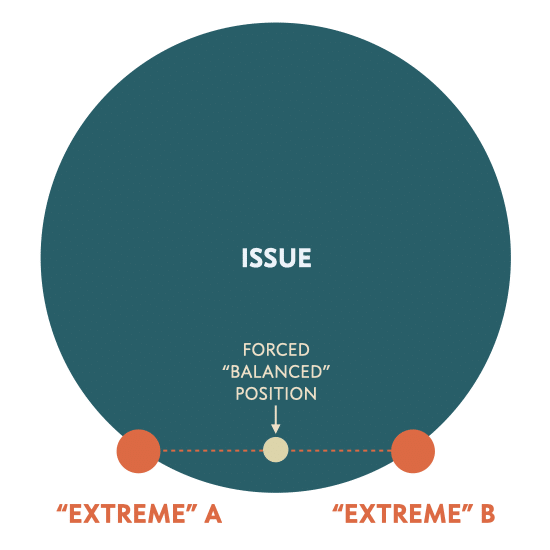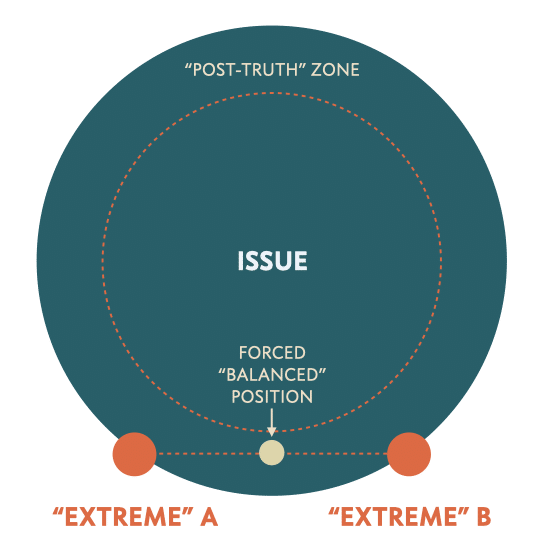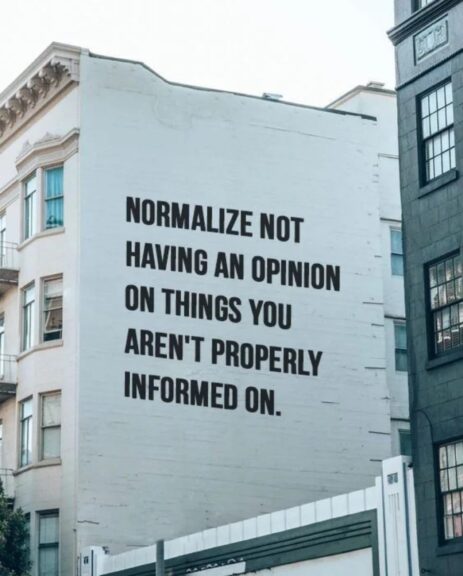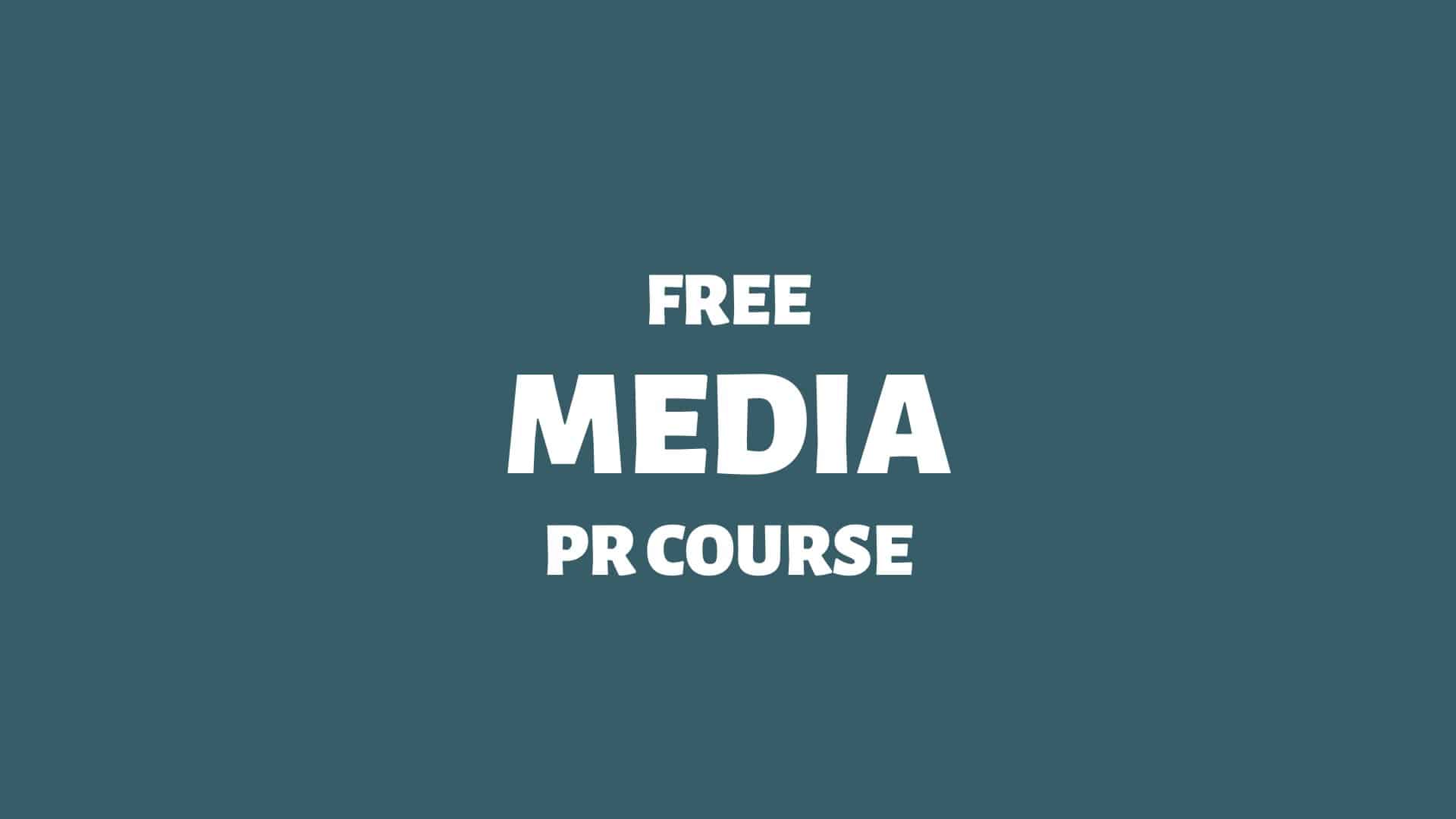The media polarisation model explains a media bias.
The news media tends to divide issues into two opposing camps. This kind of polarisation is a known media logic effect.
However, when opposing viewpoints are both extremes, the viewpoints might actually be closer to each other than to the true centre of the issue.
What happens when extreme positions (that are non-perpendicular) become less interested in honest discource based on factual evidence?
Here we go:
The Media Polarisation Model
We often hear how the media climate is “polarised” — a known and reasonably well-understood effect of classic media logic.
It also seems true that social media logic has amplified the effects of polarisation by grouping people into echo chambers where confirmation bias, conversion theory, and the hostile media effect are allowed to roam freely without any checks and balances.
“Political elites, partisan media, and social media contribute to societal-level political polarization, leading to misperceptions of division among the electorate and fueling animosity and actual ideological polarization over time.”
Source: Current Opinion in Behavioral Sciences 1Wilson, A., Parker, V., & Feinberg, M. (2020). Polarization in the contemporary political and media landscape. Current Opinion in Behavioral Sciences, 34, 223 – 228. … Continue reading
More profoundly, media polarisation is problematic because it draws false lines between extremes that aren’t necessarily perpendicular. These “false lines” will force otherwise balanced media consumers to place themselves between the media-suggested extremes.

At the extremes, sheltered by the social safety of a like-minded peer group (i.e. echo chamber), it’s possible to disregard opposing evidence as “attacks” on their position. As the amplification hypothesis states, any such attacks will only strengthen the position of the extremes.
The harder you attack someone verbally, the more you convince them of their belief, not yours.
The Post-Truth Zone
The amplification hypothesis sustains a post-truth zone at the extremes through media polarisation. If a) the zone is wide enough and b) the extremes are sufficiently close to each other, the forced “balanced” position between them will also result in the post-truth zone.
“Post-truth is a societal phenomenon, influenced by the expectation that honesty is the default position, and the public tolerance of inaccurate and undefended allegations in politics.”
Source: Nature 2Higgins, K. (2016). Post-truth: a guide for the perplexed. Nature, 540, 9 – 9. https://doi.org/10.1038/540009a

Since the forced “balanced” position will have a hard time sheltering anyone from our fear of social isolation, the spiral of silence partially explains why extremes are so effective in silencing the majority of otherwise balanced media consumers. 3Silfwer, J. (2020, June 4). The Spiral of Silence. Doctor Spin | The PR Blog. https://doctorspin.net/spiral-of-silence/
Why Media Polarisation is Disturbing
Like everyone else, I have opinions. However, as a PR professional with 18+ years of experience, I can analyse media issues without siding with any of the extremes.
But no matter how professional my analysis of a current media issue is, I risk blowback from left and right extremes — with no backing from the silent majority.
Many feel compelled by the news media to choose between outlandish extremes — or settle for an equally outlandish middle ground.
Media trends tend to be cyclical, and I estimate that the post-truth era peaked in 2019. My hope, however, is that the pandemic, followed by global inflation and AI progress, will dampen the media’s interest in extreme positions and shrink the width of the post-truth zone.
“Post-truth communication has shaped our understanding of truth, politics, and the media, with its impact on public policy, history, and social media.”
Source: Social Studies of Science 4Sismondo, S. (2017). Post-truth? Social Studies of Science, 47, 3 — 6. https://doi.org/10.1177/0306312717692076
Still, it’s disturbing that the rational business decision for many academics, professionals, and organisations is to strategically steer clear of topics taken “hostage” by left and right extremists — or for organisations to opt for the media blackout tactic.
Normalise Not Having an Opinion
More often than not, in a post-truth society, having no opinion suddenly seems like the only rational escape.

My opinion?
Let’s normalise not having one.
The iron prescription (mental model). Senior advisor Charlie Munger argued: “I have what I call an ‘iron prescription’ that helps me keep sane when I naturally drift toward preferring one ideology over another. I feel that I’m not entitled to have an opinion unless I can state the arguments against my position better than the people who are in opposition. I think that I am qualified to speak only when I’ve reached that state” (Knodell, 2016). 5Knodell, P. A. (2016). All I want to know is where I’m going to die so I’ll never go there: Buffett & Munger – A study in simplicity and uncommon, common sense. PAK Publishing.
Learn more: The Media Polarisation Model
Example: The Climate Change Issue
When discussing climate change, one extreme position often portrayed by the news media and social media algorithms is that the only viable course of action to save our planet from certain doom is to resort to a more totalitarian rule of law. Only then can we enforce the necessary actions.
Another extreme position is that the climate change issue is an elaborate hoax and that our only viable course of action is to resort to a more totalitarian rule where dangerous revolutionaries can be dealt with — before they’re allowed to destroy our societies from within.
Both extreme positions are flirting with totalitarian ideas. A straight line between them won’t include common ideas like trust in the democratic process, free speech, or humanism.
Therefore, we should all be mindful when allowing the news media and social media algorithms to dictate our choices regarding what to think, say, and do.
Read also: PR Commentary on Current Events, No Thanks

THANKS FOR READING.
Need PR help? Hire me here.

What should you study next?
Spin Academy | Online PR Courses

Spin’s PR School: Free Media PR Course
Elevate your public relations skills with this free Media PR Course—a must-have resource for all aspiring public relations professionals. Boost your career now!
Media Theory
Media Logic
Journalism
Digital Media
Learn more: All Free PR Courses
💡 Subscribe and get a free ebook on how to get better PR.

Annotations
| 1 | Wilson, A., Parker, V., & Feinberg, M. (2020). Polarization in the contemporary political and media landscape. Current Opinion in Behavioral Sciences, 34, 223 – 228. https://doi.org/10.31234/osf.io/yqvzc |
|---|---|
| 2 | Higgins, K. (2016). Post-truth: a guide for the perplexed. Nature, 540, 9 – 9. https://doi.org/10.1038/540009a |
| 3 | Silfwer, J. (2020, June 4). The Spiral of Silence. Doctor Spin | The PR Blog. https://doctorspin.net/spiral-of-silence/ |
| 4 | Sismondo, S. (2017). Post-truth? Social Studies of Science, 47, 3 — 6. https://doi.org/10.1177/0306312717692076 |
| 5 | Knodell, P. A. (2016). All I want to know is where I’m going to die so I’ll never go there: Buffett & Munger – A study in simplicity and uncommon, common sense. PAK Publishing. |


